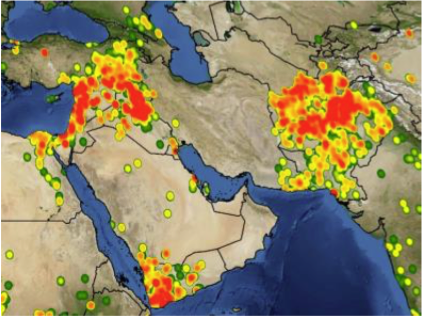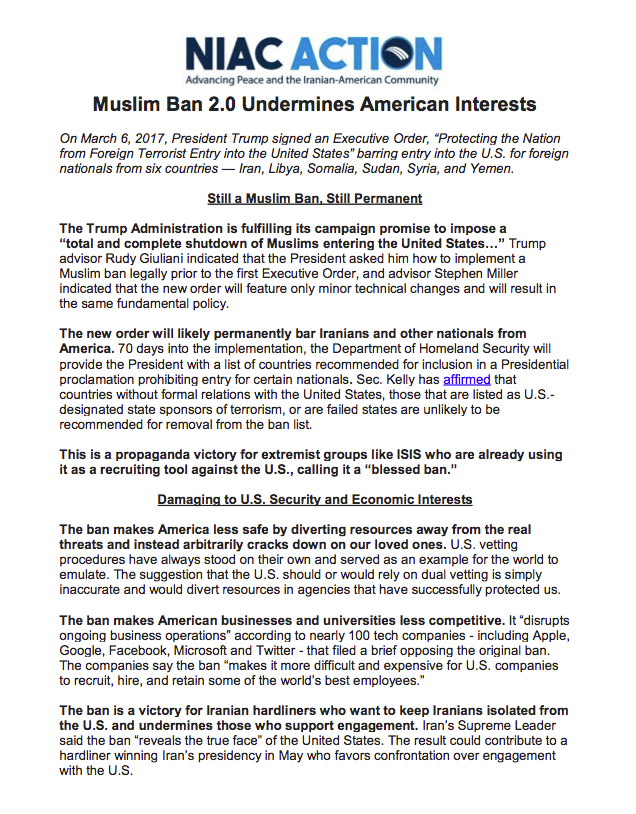On March 6, 2017, President Trump signed an Executive Order, “Protecting the Nation from Foreign Terrorist Entry into the United States” barring entry into the U.S. for foreign nationals from six countries — Iran, Libya, Somalia, Sudan, Syria, and Yemen.
Still a Muslim Ban, Still Permanent
The Trump Administration is fulfilling its campaign promise to impose a “total and complete shutdown of Muslims entering the United States…” Trump advisor Rudy Giuliani indicated that the President asked him how to implement a Muslim ban legally prior to the first Executive Order, and advisor Stephen Miller indicated that the new order will feature only minor technical changes and will result in the same fundamental policy.
The new order will likely permanently bar Iranians and other nationals from America. 70 days into the implementation, the Department of Homeland Security will provide the President with a list of countries recommended for inclusion in a Presidential proclamation prohibiting entry for certain nationals. Sec. Kelly has affirmed that countries without formal relations with the United States, those that are listed as U.S.-designated state sponsors of terrorism, or are failed states are unlikely to be recommended for removal from the ban list.
This is a propaganda victory for extremist groups like ISIS who are already using it as a recruiting tool against the U.S., calling it a “blessed ban.”
Damaging to U.S. Security and Economic Interests
The ban makes America less safe by diverting resources away from the real threats and instead arbitrarily cracks down on our loved ones. U.S. vetting procedures have always stood on their own and served as an example for the world to emulate. The suggestion that the U.S. should or would rely on dual vetting is simply inaccurate and would divert resources in agencies that have successfully protected us.
The ban makes American businesses and universities less competitive. It “disrupts ongoing business operations” according to nearly 100 tech companies – including Apple, Google, Facebook, Microsoft and Twitter – that filed a brief opposing the original ban. The companies say the ban “makes it more difficult and expensive for U.S. companies to recruit, hire, and retain some of the world’s best employees.”
The ban is a victory for Iranian hardliners who want to keep Iranians isolated from the U.S. and undermines those who support engagement. Iran’s Supreme Leader said the ban “reveals the true face” of the United States. The result could contribute to a hardliner winning Iran’s presidency in May who favors confrontation over engagement with the U.S.
An Irrational Counterterrorism Policy
Not a single person has been killed in the U.S. by a terrorist attack committed by people from the countries subjected to Trump’s ban. None of the 9/11 hijackers would have been targeted by this ban. Neither would the San Bernardino attackers or the Orlando nightclub gunman. September 11th was staged by 15 Saudi, 2 UAE, 1 Egyptian, and 1 Lebanese terrorist. San Bernardino was conducted by 1 Pakistani American and 1 Pakistani who was radicalized in Saudi Arabia. The Orlando nightclub attack was committed by 1 Afghan American.
The Department of Homeland Security Office of Intelligence and Analysis disputed the security benefits of the ban. After the initial ban was suspended, the Trump administration sought affirmation from agencies by requesting intelligence to support its pre-determined policy of a Muslim ban, though no convincing justification was found. A DHS intelligence report indicated that nationals of the targeted countries are “rarely implicated in U.S.-based terrorism,” and that citizenship is an “unreliable indicator of terrorist threat to the United States.”
The overwhelming majority of so-called “radical Islamic” terrorism attacks in the U.S. have been committed by lone wolf attackers with no sponsorship. Such lone wolves include the Boston bombers, San Bernardino shooters, Orlando nightclub shooter, OSU shooter, and Fort Hood shooter. The only recent example of terrorism on U.S. soil that may have included some state sponsorship was 9/11 and the alleged sponsors were certain Saudi officials. It is also notable that all of these particular terrorists adhered to an extreme Wahhabi ideology that also views most Iranians as apostates
Nobody from the banned countries receives a visa without visiting an embassy or consulate. Secretary of Homeland Security John Kelly has on numerous occasions misleadingly suggested that vetting cannot occur in countries without a U.S. consulate without adding that individuals in states without consulates must still visit a consulate. Iranians, for example, travel to consulates in Dubai, Ankara or Yerevan to attend visa interviews.
The notion that Yemen, Syria, Somalia, and Libya were banned due to their status as failed states with armed conflict is dubious. If the U.S. were to ban visas for all countries with ungoverned regions controlled by armed groups the list would have to include: Afghanistan, Colombia, Honduras, India, Israel, Egypt, El Salvador, Kenya, Mexico, Pakistan, Russia, Turkey, and Ukraine to name a few.
Punishing the Iranian People
The ban will impact more Iranians and Iranian Americans than any other group on the restricted countries list. In 2015, 57.5% of the visas issued to the 6 targeted countries went to Iranians (42,542).
Iranians are one of the only populations in the region who have positive views of the United States. After 9/11, Iranians held vigils in solidarity with America. Iranians want to buy American goods and study in American schools. Donald Trump may single-handedly destroy this goodwill.
The majority of Iranians view the American people favorably according to a poll conducted by the University of Maryland one year after the nuclear deal. 80% of Iranians supported increased tourism and 68% supported more cultural and athletic exchanges such as the recent trip by the U.S. wrestling team to Tehran which occurred without incident.
The ban does nothing to punish the Iranian government for its inclusion on the U.S. State Sponsors of Terror list. The punishment is almost exclusively felt by innocent Iranian nationals who seek entry into the United States for educational purposes, family visits, tourism, and medical care. It is these people seeking a positive connection with America – not Iranian government officials – who are targeted.
Iran remains a stable country and is neither a failed state nor a conflict zone. This map of 2015 terrorist attacks generated by the University of Maryland reveals that Iran is wedged between terrorism hotspots that are not on the list:

A PDF version of this memo can be found here.
Back to top